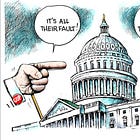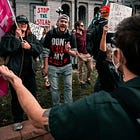The Danger of Declining Religious Literacy
More and more political arguments are abominably mistranslated
Religion is both the first liberty cited in the First Amendment and the only one that gets two clauses. There are reasons for this. First, trendy historical revisionism aside, the colonists who settled the land that would become America were primarily motivated by their desire for religious autonomy. Second, in their world, religion was the core of existence, as it had been for people everywhere for thousands of years.
A brief tour of world history reveals the importance of religion to people, just as a brief scan of the news reveals the continued importance of religion to people. Before the Colonial Age, most of history’s wars had a religious dimension, and many still do—the Israel-Hamas War, for example.
All over the world, religion is still central to the lives of billions of people. Millions of them live in America.
However, the pace of secularization has quickened in recent years. In 1972, 95% of Americans identified with a religion, 90% of them Christian and 5% “other,” according to Pew Research Center. The remaining 5% identified as unaffiliated. Those numbers remained stable through the early-1990s, when the percentage of Christian-identifiers started to gradually decline, whereas the number of unaffiliateds began to steadily rise.
By the late-1990s, only about 80% of Americans identified as Christian, according to Pew, while around 15% claimed no religious affiliation. Those figures plateaued again briefly until the mid-2000s, when they resumed their respective trends.
Fast-forward to the early-2010s, and the number of self-professed Christians dipped down near 70%, while the number of those who don’t affiliate hit 20%. Finally, by 2021, only 63% called themselves Christian, and an eyebrow-raising 29% declined to affiliate. (The number of those who identify as “other,” who predominantly consist of Jews and Muslims, has remained relatively constant since 1972, according to Pew).
Secularization has accelerated even more in the last decade. In 2013, 72% of Americans considered religion to be an important aspect of their lives, and 27% considered it the most important aspect, according to the Public Religion Research Institute (PRRI). In 2023, only 53% considered religion important, and only 15% deemed it most important.
PRRI also found a notable drop in church attendance in the 21st century. In 2000, about one-third of Americans still frequented weekly services, and less than 15% claimed to never attend. As of 2023, only 20% attended weekly (in-person or virtual), and about one-third said they never attend. The average congregation size of Christian churches has also been more than halved over approximately the same time span, from 137 in 2000 to 65 in 2020, according to Faith Communities Today, a multi-faith research initiative.
Also, based on findings from the National Bureau of Economic Research, three-quarters of those who claim to be among the churchgoing faithful are lying before God and pollsters. After tracking location data from the cell phones of two million Americans in 2019—before Covid—bureau researchers estimated that the actual number of Americans who were attending church every week was only 5%.
Empty pews have led churches to close or consolidate in order to avoid closing. In 2019 alone—again, before Covid—1,500 Protestant churches closed, per Lifeway Research, a church consultant group.
Meanwhile, research from Georgetown University cited in The Catholic World reveals that, in 1970, 55% of self-identifying Catholics in the U.S. went to mass at least once a week. By 2022, that number was down to 17%. The Church also ordained only 451 new American priests in 2022, 44% less than the 805 that were ordained in 1972.
The dechurching of the U.S. has led to a steep fall in what might be called “religious literacy.” In other words, most Americans, until recent decades, were basically familiar with the general beliefs of Christianity, America’s main faith. This included nonreligious folks also. They comprehended how observant Christians think, and they were familiar with religious vernacular.
This has changed over the last several generations. One of the byproducts of steadily increasing, national irreligiosity is that each generation becomes progressively less fluent in topics of faith.
As this religious attrition has been taking place, the religious foundations of U.S. society have simultaneously been torn out by courts and culture. A secular technocracy has emerged in place of what was once a “Christian nation.”
The cumulative effect of these shifts is that religious views that were standard until recent years and are still maintained by millions of Americans now seem antiquated to millions of other Americans. Instead of seeing faith-based ideas as views they don’t agree with, but whose origin they grasp, today’s nonbelievers see those same views as obsolete and connected to a repressive past—if they are even acquainted with the ideas.
America’s loss of religious literacy is significant because it fuels the culture war. It results in the misunderstanding and misrepresentation of political views on a litany of issues as, at best, archaic, and, more typically, prejudiced and hateful. To those who don’t know the language of religion, what else could anti-abortion people but be patriarchal supremacists? And who else would oppose any pro-LGBT policies except homophobic bigots?
Political parties are naturally keen to stoke these misconceptions. It serves Democratic ends immensely, for instance, when women and LGBT individuals and their allies see opponents of abortion and pro-LGBT policies depicted in precisely these ways (just as it serves Republican ends for abortion and LGBT policy supporters to be seen as baby-slaughtering hedonists and depraved heathens who aim to destroy the traditional family).
But, raising religious literacy back to at least a functional level wouldn’t be difficult. Simply reintroducing society to the concept of “hate the sin; love the sinner” would do it. (While this is a biblical precept that is derived from Christianity, it’s applicable to most faiths because most clearly differentiate between actions they consider “bad” and the people who do them, who aren’t viewed as bad, but just human).
And to be fair, nonreligious folks aren’t the only ones who need to relearn this principle. People of faith frequently seem to forget about the second half of the teaching. In today’s hyperpolitical atmosphere, some believers come across as if they’ve contorted the message into “hate the sinner.”
The challenge for believers is to reinternalize their own belief that, although a person’s actions or views may be “wrong” in their eyes, that doesn’t make the person any less deserving of divine love. Nor does it release believers from their charge to treat that person with love.
Meanwhile, the challenge for nonbelievers is to take believers’ beliefs at face value. Even if you believe believers themselves are backward, superstitious dupes, can you let them have their beliefs—without attributing malice to them?
* Portions of this post have been adapted from my upcoming book The Anti-Partisan Manifesto: How Parties and Partisanism Divide America and How to Shut Them Down (2024).









Well said, thx